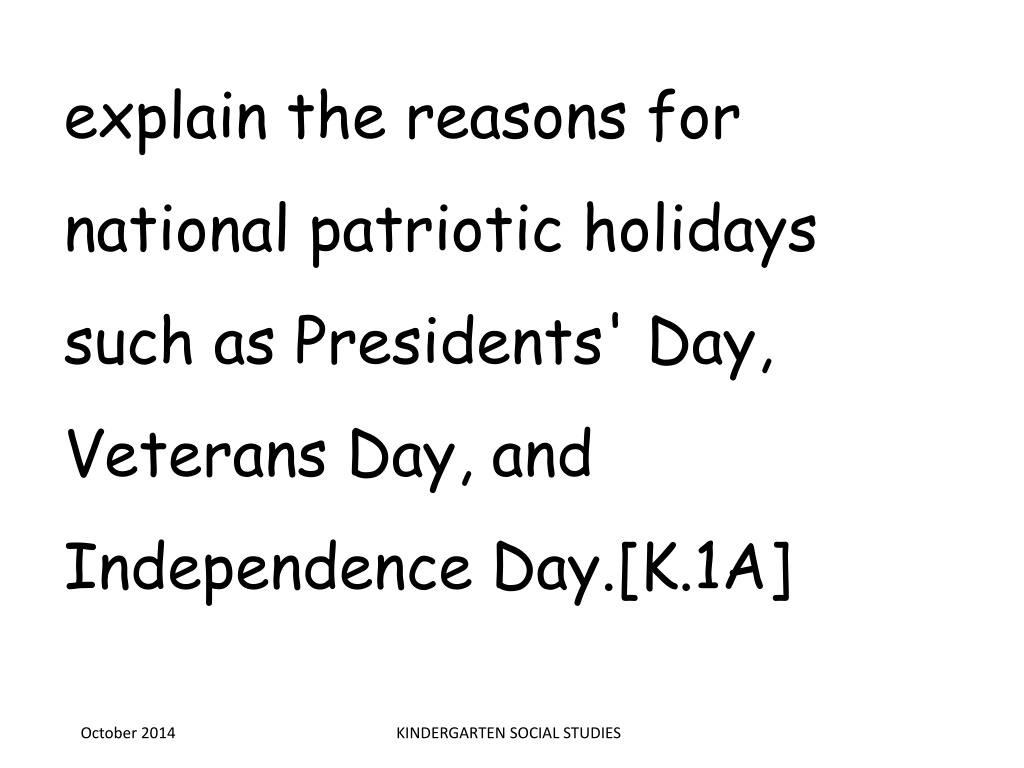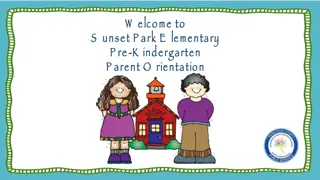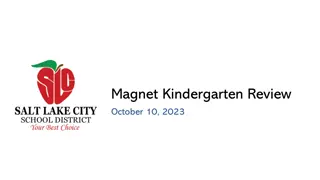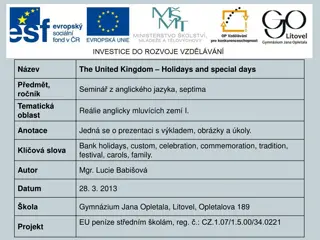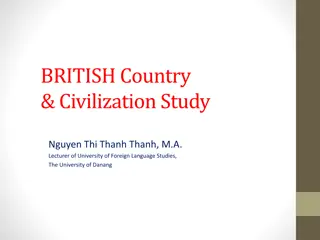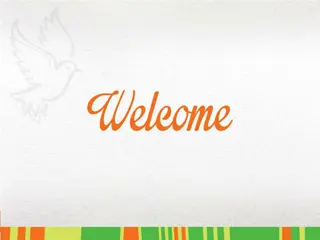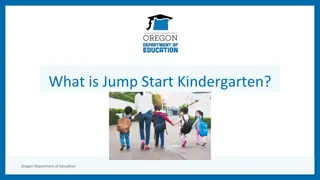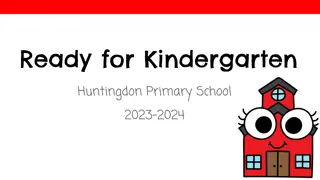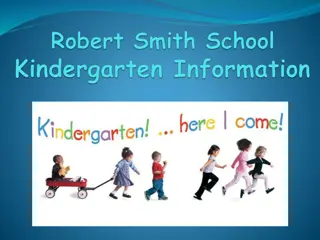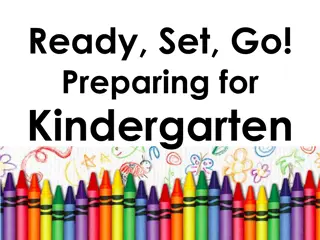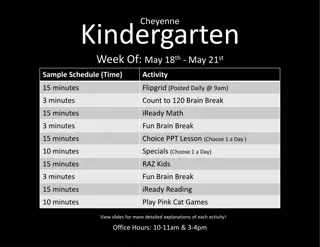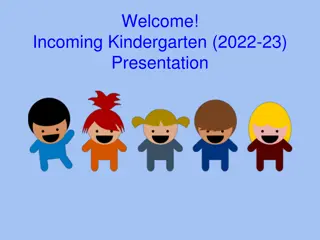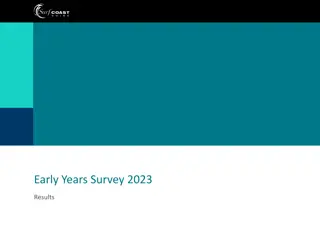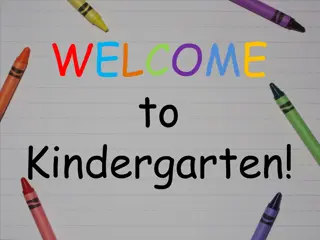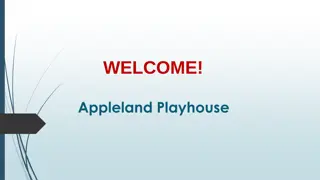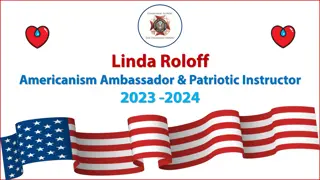Understanding National Patriotic Holidays in Kindergarten Social Studies
In Kindergarten Social Studies, children learn about national patriotic holidays such as Presidents' Day, Veterans Day, and Independence Day. They explore the reasons behind these holidays, customs associated with them like parades and fireworks on Independence Day, contributions of historical figures, and how events are placed in chronological order. They also start using vocabulary related to time, terms to describe relative location, and tools like maps and globes for determining location. Additionally, they identify physical characteristics of places such as landforms, bodies of water, natural resources, and weather.
Download Presentation

Please find below an Image/Link to download the presentation.
The content on the website is provided AS IS for your information and personal use only. It may not be sold, licensed, or shared on other websites without obtaining consent from the author. Download presentation by click this link. If you encounter any issues during the download, it is possible that the publisher has removed the file from their server.
E N D
Presentation Transcript
explain the reasons for national patriotic holidays such as Presidents' Day, Veterans Day, and Independence Day.[K.1A] October 2014 KINDERGARTEN SOCIAL STUDIES
identify customs associated with national patriotic holidays such as parades and fireworks on Independence Day.[K.1B] October 2014 KINDERGARTEN SOCIAL STUDIES
identify contributions of historical figures, including Stephen F. Austin, George Washington, Christopher Columbus, and Jos Antonio Navarro, who helped to shape the state and nation.[K.2A] October 2014 KINDERGARTEN SOCIAL STUDIES
place events in chronological order.[K.3A] October 2014 KINDERGARTEN SOCIAL STUDIES
use vocabulary related to time and chronology, including before, after, next, first, last, yesterday, today, and tomorrow.[K.3B] October 2014 KINDERGARTEN SOCIAL STUDIES
use terms, including over, under, near, far, left, and right, to describe relative location.[K.4A] October 2014 KINDERGARTEN SOCIAL STUDIES
locate places on the school campus and describe their relative locations.[K.4B] October 2014 KINDERGARTEN SOCIAL STUDIES
identify tools that aid in determining location, including maps and globes.[K.4C] October 2014 KINDERGARTEN SOCIAL STUDIES
identify the physical characteristics of place such as landforms, bodies of water, natural resources, and weather.[K.5A] October 2014 KINDERGARTEN SOCIAL STUDIES
identify how the human characteristics of place such as ways of earning a living, shelter, clothing, food, and activities are based upon geographic location.[K.5B] October 2014 KINDERGARTEN SOCIAL STUDIES
identify basic human needs of food, clothing, and shelter.[K.6A] October 2014 KINDERGARTEN SOCIAL STUDIES
explain the difference between needs and wants.[K.6B] October 2014 KINDERGARTEN SOCIAL STUDIES
explain how basic human needs can be met such as through self-producing, purchasing, and trading.[K.6C] October 2014 KINDERGARTEN SOCIAL STUDIES
identify jobs in the home, school, and community.[K.7A] October 2014 KINDERGARTEN SOCIAL STUDIES
explain why people have jobs.[K.7B] October 2014 KINDERGARTEN SOCIAL STUDIES
identify purposes for having rules.[K.8A] October 2014 KINDERGARTEN SOCIAL STUDIES
identify rules that provide order, security, and safety in the home and school.[K.8B] October 2014 KINDERGARTEN SOCIAL STUDIES
identify authority figures in the home, school, and community.[K.9A] October 2014 KINDERGARTEN SOCIAL STUDIES
explain how authority figures make and enforce rules.[K.9B] October 2014 KINDERGARTEN SOCIAL STUDIES
identify the flags of the United States and Texas.[K.10A] October 2014 KINDERGARTEN SOCIAL STUDIES
recite the Pledge of Allegiance to the United States Flag and the Pledge to the Texas Flag.[K.10B] October 2014 KINDERGARTEN SOCIAL STUDIES
identify Constitution Day as a celebration of American freedom.[K.10C] October 2014 KINDERGARTEN SOCIAL STUDIES
use voting as a method for group decision making. [K.10D] October 2014 KINDERGARTEN SOCIAL STUDIES
identify similarities and differences among people such as kinship, laws, and religion.[K.11A] October 2014 KINDERGARTEN SOCIAL STUDIES
identify similarities and differences among people such as music, clothing, and food.[K.11B] October 2014 KINDERGARTEN SOCIAL STUDIES
describe and explain the importance of family customs and traditions.[K.12A] October 2014 KINDERGARTEN SOCIAL STUDIES
compare family customs and traditions.[K.12B] October 2014 KINDERGARTEN SOCIAL STUDIES
identify examples of technology used in the home and school.[K.13A] October 2014 KINDERGARTEN SOCIAL STUDIES
describe how technology helps accomplish specific tasks and meet people's needs.[K.13B] October 2014 KINDERGARTEN SOCIAL STUDIES
describe how his or her life might be different without modern technology.[K.13C] October 2014 KINDERGARTEN SOCIAL STUDIES
